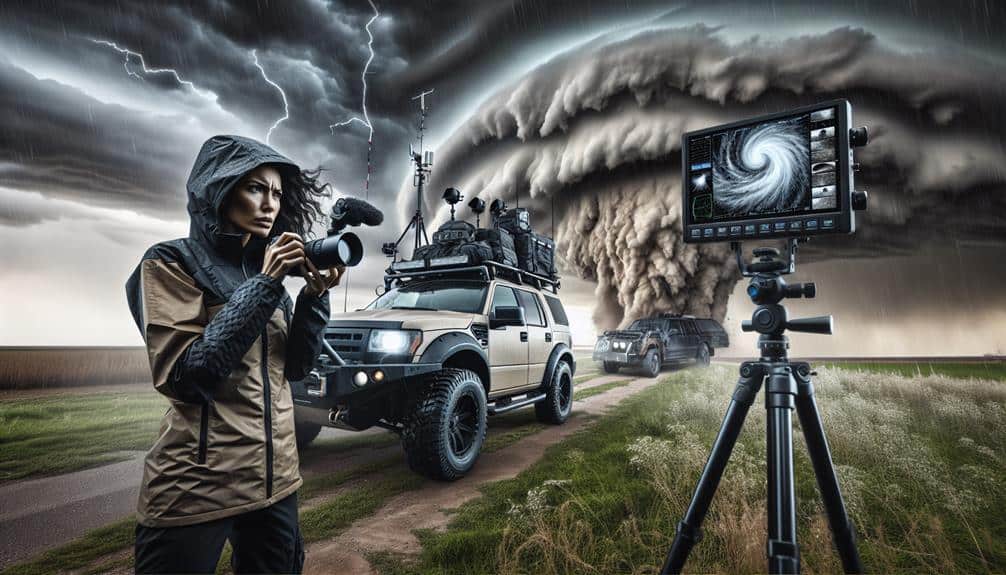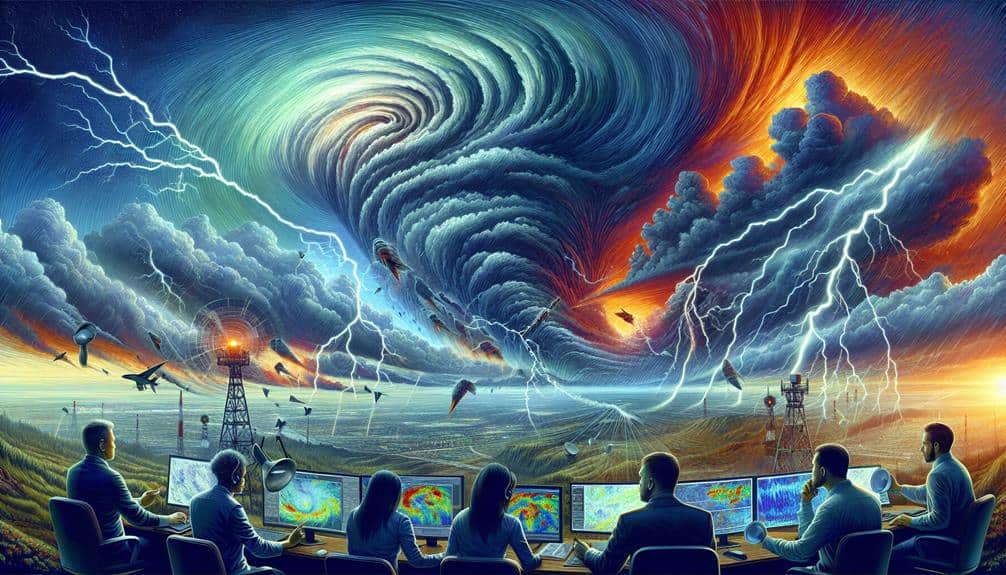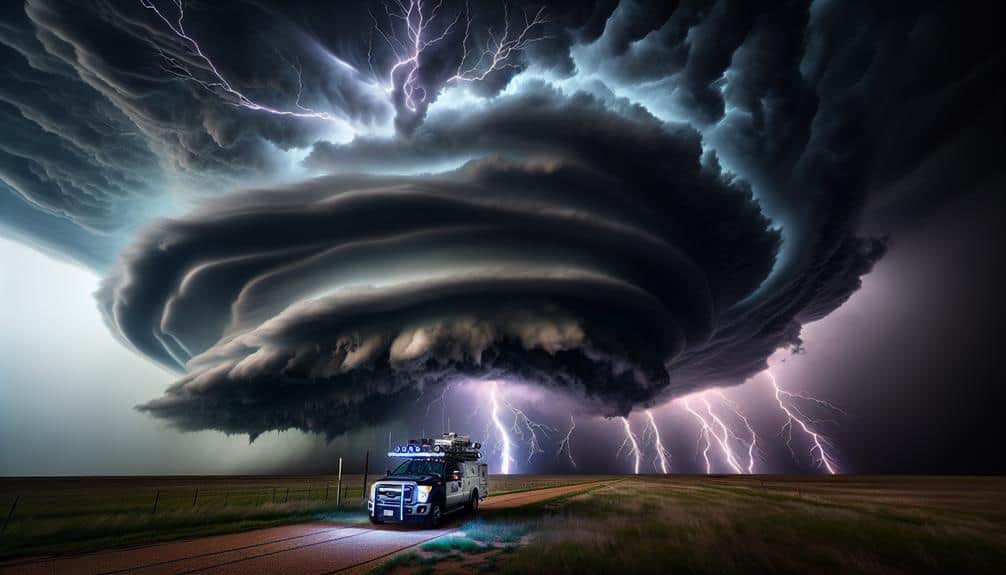We chase supercell storms for their unparalleled combination of scientific insights, dramatic beauty, and adrenaline-fueled adventure. The intense atmospheric dynamics provide an unparalleled rush as we measure wind speeds exceeding 100 mph. We collect high-resolution data on pressure and precipitation, enhancing our weather forecasts and predictive models. Our photographs capture rare cloud formations, contributing to meteorological research and inspiring awe. The storm-chasing community fosters collaboration and rigorous data analysis. By tracking mesocyclones and other rare weather phenomena, we refine theoretical models and improve forecasting accuracy. Exploring these elements deeply has profound impacts on both our knowledge and personal growth.
Key Points
- Experience the adrenaline rush of witnessing intense atmospheric dynamics and breathtaking storm visuals.
- Contribute to scientific discovery by uncovering unique atmospheric phenomena and improving weather forecasts.
- Capture dramatic sky transformations and rare cloud formations through high-resolution photography.
- Enhance meteorological research by collecting real-time, high-resolution data on wind speeds, pressure, and precipitation.
Unmatched Adrenaline Rush
Chasing supercell storms delivers an unmatched adrenaline rush due to the intense atmospheric dynamics and unpredictable nature of these powerful weather systems. When we position ourselves in the path of a supercell, the heart-pounding excitement surges as we observe the mesocyclone's towering, rotating updraft. The data we gather from these encounters reveal that wind speeds within a supercell can exceed 100 mph, contributing to the breathtaking views of swirling cloud formations and lightning displays.
Each chase offers a unique natural spectacle, providing an adrenaline boost that's hard to replicate. We often find ourselves in awe of the storm's raw power and beauty. The awe-inspiring visuals of mammatus clouds and the eerie green sky, indicative of hail, are textbook examples of atmospheric phenomena that captivate our senses. Our experiences aren't just about the thrill; they're grounded in the empirical analysis of storm structures and behavior.
The unpredictability of these storms means we're constantly on high alert, analyzing radar data and adjusting our position. This dynamic interplay between observation and reaction fuels our desire for freedom, allowing us to immerse ourselves in nature's most formidable displays.
Scientific Discovery Opportunities
When we chase supercell storms, we can uncover unique atmospheric phenomena that are otherwise difficult to study.
By collecting real-time data, we enhance our understanding of storm dynamics, which contributes to more accurate predictive models.
Our field observations help improve the accuracy of weather forecasts and advance meteorological research.
Uncover Atmospheric Phenomena
Delving into supercell storms offers unparalleled opportunities to uncover atmospheric phenomena that can enhance our understanding of severe weather patterns. As storm chasers, we immerse ourselves in the dynamics of these powerful systems, capturing real-time data and visual evidence.
Utilizing advanced photography tips, we document the intricate structures of rotating updrafts and mesocyclones. This visual data is essential for analyzing how atmospheric phenomena evolve and interact within supercell environments.
Supercell storms provide a natural laboratory for observing the formation of phenomena such as wall clouds, funnel clouds, and the elusive tornado genesis. By systematically studying these events, we can identify patterns and mechanisms that drive their development.
For instance, understanding the conditions that lead to tornado formation within a supercell can greatly improve predictive models, thereby enhancing public safety.
Our hands-on approach in storm chasing not only satisfies a quest for freedom and adventure but also contributes to the scientific community. By meticulously documenting weather patterns, we generate valuable insights that can be shared with meteorologists and researchers.
This collaborative effort accelerates progress in meteorological science, uncovering the complexities of our atmosphere and paving the way for more accurate forecasting techniques.
Data Collection Enhancement
Enhancing data collection during supercell storms significantly boosts our scientific discovery opportunities by providing precise observations and measurements in real-time. When we engage in storm chasing, we're not simply thrill-seekers; we're on the frontier of weather science, capturing vital data that stationary instruments often miss.
By deploying mobile radar units and atmospheric probes, we can gather high-resolution data on wind speeds, pressure variations, and precipitation rates directly within the storm. Our approach allows us to analyze these datasets meticulously, offering insights into the formation and evolution of supercells.
This data analysis is essential for understanding complex weather patterns and improving predictive models. The information we obtain can lead to significant research advancements, aiding meteorologists in forecasting severe weather more accurately.
Moreover, the real-time data collection during storm chasing provides an unparalleled opportunity to validate and refine existing theoretical models. By comparing observed data with predicted outcomes, we can identify discrepancies and enhance our understanding of storm dynamics.
This iterative process drives continuous improvement in weather prediction and hazard mitigation strategies, directly contributing to public safety. Essentially, our proactive approach to storm chasing and data collection not only satisfies scientific curiosity but also empowers communities with better preparedness.
Captivating Photography Moments
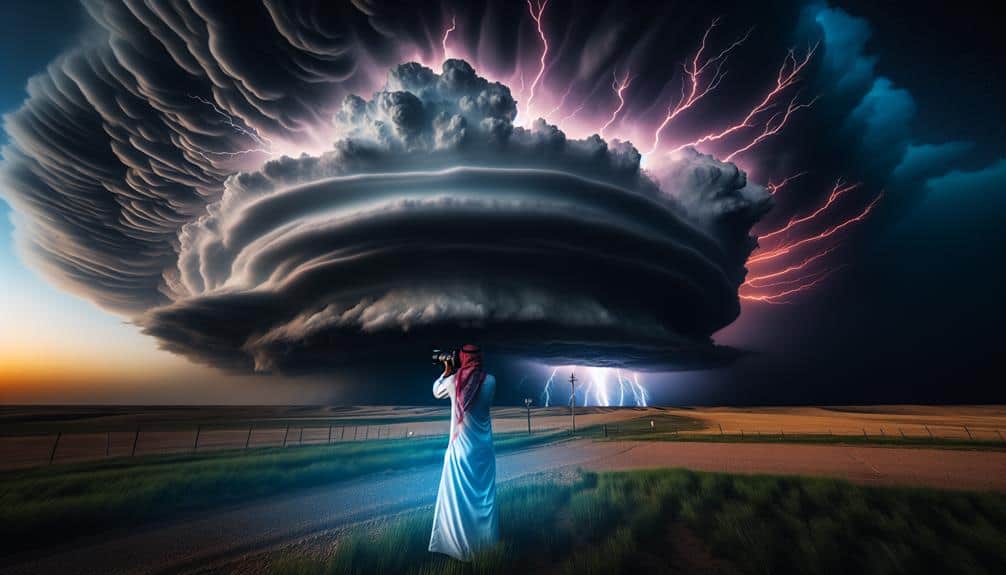
When we chase supercell storms, we capture dramatic sky transformations and unique lighting effects that are rarely seen in other meteorological phenomena. Our data shows that these conditions create rare cloud formations, offering unparalleled opportunities for high-impact photography.
Dramatic Sky Transformations
Supercell storms often present unique opportunities for capturing the dramatic changes of the sky, yielding compelling and scientifically valuable images. The sky drama these storms create is unparalleled, offering a front-row seat to some of nature's most awe-inspiring weather wonders. By chasing supercell storms, we can document cloud changes that reveal the atmospheric beauty and complexity of these systems.
When analyzing supercell storms, we observe phenomena such as rotating updrafts known as mesocyclones, which provide visual evidence of the storm's internal dynamics. These mesocyclones can create striking cloud formations, including wall clouds and mammatus clouds, that enhance our understanding of storm structure. High-resolution photography allows us to capture these changes in precise detail, providing data essential for meteorological research.
Moreover, the rapid changes in cloud formations during a supercell event offer a dynamic canvas for photographers and scientists alike. Capturing these moments requires not only technical skill but also a deep appreciation for the atmospheric processes at play.
Each image serves as a tribute to the storm's power and the intricate dance of natural forces, inspiring both scientific inquiry and a profound sense of freedom in witnessing such raw, unfiltered beauty.
Unique Lighting Effects
The interplay of light and shadow during supercell storms creates unique lighting effects that are both visually stunning and essential for understanding the storm's structure and dynamics. When we chase these storms, we're not just after the thrill; we're seeking to capture those fleeting moments where light reveals the intricacies of the storm.
Lightning strikes, for instance, provide an immediate and dramatic illumination of the storm's anatomy, revealing the swirling mesocyclone and updraft towers that are otherwise shrouded in darkness.
In storm photography, timing is everything. The golden hour, typically just before sunset, offers a natural backdrop of warm light that contrasts with the ominous, dark clouds, creating a visually striking scene. High-speed cameras allow us to capture lightning strikes in precise detail, offering a split-second glimpse into the storm's electrical activity. Data from these photographs can be analyzed to understand the frequency and intensity of lightning, which correlates with storm severity.
As storm chasers, we're driven by the desire to document these mesmerizing moments. The unique lighting effects not only provide us with awe-inspiring images but also critical data that advances our scientific understanding of supercell dynamics.
Rare Cloud Formations
Our pursuit of supercell storms often rewards us with the opportunity to capture rare cloud formations that are as scientifically valuable as they're visually stunning. These formations, such as mammatus, shelf clouds, and wall clouds, provide essential data for atmospheric research and enhance our understanding of severe weather dynamics. By mastering cloud identification, we can pinpoint the intricacies of these phenomena, contributing to both science and art.
Utilizing advanced storm chasing techniques, we strategically position ourselves to observe and photograph these extraordinary cloud structures. Techniques like GPS tracking, real-time radar analysis, and understanding storm motion vectors allow us to predict where and when these clouds will manifest. This precision not only guarantees our safety but also maximizes our opportunities for capturing mesmerizing moments.
The data we gather extends beyond visuals; atmospheric pressure readings, humidity levels, and wind speeds all play roles in the formation of these rare clouds. By analyzing this data, we can refine predictive models, improving future storm forecasts.
Therefore, storm chasing becomes a harmonious blend of freedom, adventure, and scientific inquiry, offering us unparalleled experiences while advancing meteorological knowledge.
Sense of Community
Chasing supercell storms fosters a unique sense of community among storm chasers, supported by shared experiences and collaborative data collection. Our collective weather passion drives us to rigorous data analysis and real-time communication.
When we engage in storm chasing, we're not just individuals in pursuit of meteorological phenomena; we're a cohesive unit, each contributing to the community support that aids in our shared mission.
The shared experiences we encounter during storm chasing are unparalleled. The adrenaline rush of tracking a developing mesocyclone, or the awe of witnessing a perfectly formed anvil cloud, creates bonds that transcend ordinary social interactions.
These moments of intense observation and data gathering are essential for our scientific objectives, but they also solidify our sense of belonging within this specialized community.
Learning Meteorology Firsthand

When we chase supercell storms, we hone our field observation techniques and collect real-time data that can't be replicated in a lab.
By analyzing atmospheric pattern recognition, we gain invaluable insights into storm development and behavior.
This hands-on experience enhances our understanding of meteorological phenomena more effectively than theoretical study alone.
Field Observation Techniques
Understanding supercell dynamics through field observation techniques provides invaluable firsthand experience in meteorology.
When we engage in storm chasing missions, we adopt specific storm chasing tactics and safety measures to maximize our data collection while minimizing risk. We study weather models, analyze radar data, and identify target areas that offer the best conditions for observing supercells.
Our field equipment includes advanced meteorological instruments, GPS devices, and high-resolution cameras. This arsenal enables us to capture detailed storm structure and behavior, enhancing our understanding of these powerful systems.
Photography techniques play a critical role in documenting supercell features like wall clouds, funnel clouds, and mesocyclones. Using time-lapse photography, we can analyze storm evolution, providing insights into supercell lifecycle and dynamics.
Safety is paramount. We always maintain a safe distance from the storm's core and have escape routes planned. By prioritizing safety measures, we guarantee that our pursuit of knowledge doesn't come at the expense of our well-being.
Through meticulous planning and the use of sophisticated field equipment, we gain a deeper, firsthand understanding of supercell storms, enriching our meteorological expertise and fueling our desire for freedom and exploration.
Real-Time Data Collection
Collecting real-time data during supercell storms allows us to analyze meteorological phenomena as they unfold, offering unparalleled insights into storm dynamics and behavior. By employing advanced real-time monitoring techniques, we can capture high-resolution data on wind speeds, pressure changes, and precipitation rates. This immediate access to data enables us to make precise observations and adjustments to our storm tracking methodologies on the fly.
When we're in the field, the immediacy of real-time monitoring is essential. It allows us to pinpoint the exact locations of mesocyclones and other vital storm features, enhancing our understanding of storm structure. Using mobile Doppler radar systems and atmospheric sensors, we can observe how supercells evolve, gaining firsthand knowledge that static models can't provide. This dynamic approach not only improves our predictive capabilities but also deepens our appreciation for the complexities of meteorology.
Furthermore, real-time data collection facilitates collaborative efforts with meteorological research institutions. By sharing our findings instantly, we contribute to broader scientific endeavors aimed at improving weather prediction and public safety. Together, we harness the power of real-time data to push the boundaries of what's possible in storm tracking and meteorological research.
Atmospheric Pattern Recognition
By immersing ourselves directly in supercell environments, we gain vital insights into atmospheric pattern recognition that static models simply can't replicate. Our hands-on experiences with weather patterns and storm chasing provide us with invaluable data, enhancing our understanding of atmospheric dynamics and storm tracking.
When we chase supercell storms, we observe firsthand the intricate dance of wind, pressure, and moisture. This helps us comprehend complex atmospheric phenomena that are often oversimplified in models.
Here are some crucial elements to focus on:
- Cloud formations: Observing the development of cumulonimbus clouds gives us real-time data on storm potential and severity.
- Wind shear: By measuring changes in wind speed and direction, we can predict the likelihood of tornado formation.
- Temperature gradients: Tracking temperature shifts allows us to identify the boundaries between different air masses, which are essential for storm development.
- Precipitation patterns: Analyzing precipitation types and intensities helps us forecast flooding risks and storm longevity.
Engaging directly with supercells makes us adept at recognizing subtle atmospheric cues and refining our storm tracking skills. This boots-on-the-ground approach empowers us to forecast with greater precision, offering a sense of liberation from over-reliance on static models.
Tracking Nature's Fury
Meteorologists use advanced radar systems and storm-chasing technology to meticulously track supercells, analyzing data patterns to predict their paths and potential impact. We employ Doppler radar, satellite imagery, and ground-based sensors to gather real-time data, creating detailed models that help us understand a storm's behavior. This analytical approach not only aids in predicting the storm's trajectory but also in guaranteeing storm chasing safety. By knowing where a supercell is likely to move, we can position ourselves at a safe distance while capturing extreme weather photography.
Our radar systems detect key indicators such as wind velocity, precipitation intensity, and rotational patterns within the storm. These data points are critical for identifying the mesocyclone—the rotating updraft that can spawn tornadoes. By continuously monitoring these parameters, we can make informed decisions about when and where to chase, balancing the thrill of the pursuit with the necessity of safety.
Moreover, the high-resolution imagery we capture isn't just for dramatic effect; it provides valuable information for ongoing research and public awareness. Each photograph and video clip contributes to a broader understanding of supercell dynamics, aiding in the development of more accurate predictive models. Our data-driven approach guarantees we can responsibly experience the freedom of storm chasing without compromising safety.
Experiencing Rare Weather Phenomena
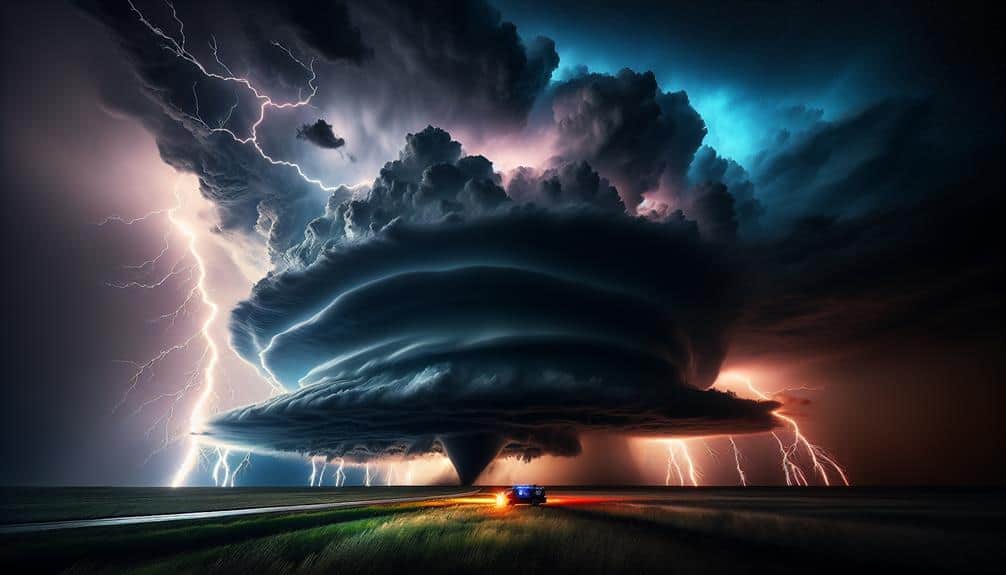
Experiencing the rare and awe-inspiring phenomena within supercell storms allows us to witness firsthand the extraordinary mechanics of severe weather systems. As thrill-seeking weather watchers, we crave the adrenaline rush that comes from observing these powerful storms up close. The unique structure and behavior of supercells offer a fascinating glimpse into nature's most dynamic processes.
When we chase supercell storms, we encounter:
- Mesocyclones: These rotating updrafts form the core of supercell storms, exhibiting wind speeds that can exceed 100 mph. The sight of a mesocyclone, with its swirling motion and towering presence, is both mesmerizing and humbling.
- Wall Clouds: These lowerings beneath the mesocyclone often signal the potential for tornado formation. The dramatic contrast between the dark, ominous wall cloud and the brighter surrounding sky creates a striking visual.
- Mammatus Clouds: These pouch-like formations hang beneath the anvil of a supercell, offering a surreal and almost otherworldly appearance. Each cluster of mammatus clouds provides a reminder of the storm's immense power.
- Hail Cores: Supercell storms can produce hailstones larger than softballs. Observing the intensity and frequency of hailfall gives us valuable insights into the storm's severity.
Contributing to Weather Research
Chasing supercell storms frequently allows us to gather critical data that significantly advances meteorological research. By employing sophisticated storm chasing techniques, we can collect real-time information on atmospheric conditions that are otherwise challenging to obtain. For instance, deploying mobile Doppler radar systems and atmospheric probes enables us to measure wind speeds, humidity levels, and temperature gradients with high precision. This data is invaluable for enhancing weather forecasting models.
When we chase supercells, we often encounter phenomena such as mesocyclones and tornadoes. Documenting these occurrences contributes to a better understanding of storm genesis and evolution. By capturing high-resolution video footage and still images, we provide visual data that complements numerical models. These models are then refined to improve their predictive accuracy, offering communities more reliable advanced warnings.
Moreover, our field observations can validate or challenge existing theoretical frameworks. For example, gathering data on supercell structures and their microphysical properties informs how we simulate these storms in computational models. This iterative process between fieldwork and modeling guarantees that our weather forecasting capabilities continuously enhance.
In essence, our storm chasing efforts directly contribute to the scientific community, fostering advancements that ultimately allow for greater autonomy and preparedness in the face of severe weather events.
Personal Achievement

While contributing to weather research is paramount, there's also a profound sense of personal achievement that comes from successfully exploring and documenting these powerful supercell storms. This endeavor isn't just about data collection; it's about personal growth and overcoming challenges that test our limits.
We engage in a journey of self-discovery, pushing our boundaries and expanding our understanding of both the natural world and ourselves.
Chasing supercell storms offers unique opportunities for:
- Personal Growth: Each storm chase requires meticulous planning and real-time decision-making, enhancing our strategic thinking and problem-solving skills.
- Overcoming Challenges: Facing the unpredictable and often dangerous elements of a supercell storm demands resilience and adaptability, fostering a mindset geared towards overcoming obstacles.
- Self-Discovery: The intensity of these experiences allows us to learn more about our capacities, fears, and strengths, leading to a deeper sense of self-awareness.
- Pushing Limits: Navigating the intricacies of storm environments pushes us beyond our comfort zones, enabling us to achieve feats we once thought impossible.
Adventure and Exploration
Exploring the core of a supercell storm presents unmatched opportunities for scientific discovery and exciting expedition. We find ourselves navigating the distant wilderness, armed with meteorological instruments, ready to capture data that can reveal secrets of these formidable natural phenomena.
The adrenaline rush is palpable as we pursue these storms, knowing that every reading and observation contributes to our understanding of atmospheric dynamics.
The distant wilderness becomes our laboratory, a place where the natural marvels of powerful winds, lightning, and heavy rain converge in a dramatic spectacle. Here, we gather crucial data on wind speeds, pressure changes, and precipitation rates, which are vital for improving weather prediction models.
This data-driven approach allows us to refine our hypotheses and validate our theories, pushing the boundaries of meteorological science.
Furthermore, the sheer unpredictability of supercell storms demands that we remain vigilant and adaptable, qualities that resonate with our quest for freedom and autonomy. The thrill of exploration, combined with the pursuit of knowledge, creates a unique blend of adventure and scientific rigor.
As we document these extraordinary events, we contribute to a deeper appreciation of the planet's natural marvels and the forces that shape them.
Frequently Asked Questions
What Safety Precautions Should I Take When Storm Chasing?
When storm chasing, we should prioritize safety by identifying emergency shelters and maintaining communication. Regularly check weather updates and have a clear evacuation plan. This analytical approach guarantees our freedom while minimizing risk.
How Do I Find Reliable Storm Chasing Tours or Guides?
Finding reliable storm chasing tours or guides can be like hunting for hidden treasure. We should prioritize tours with proven storm chasing vehicles and expertise in prime storm chasing locations to maximize our thrilling, data-driven adventure.
What Equipment Is Essential for Storm Chasing?
When it comes to essential equipment for storm chasing, we need camera gear for documenting phenomena and navigation tools for real-time tracking. Reliable data collection and precise positioning enhance our freedom to explore the most intense supercell storms safely.
How Should I Prepare My Vehicle for Storm Chasing Trips?
Did you know that 80% of storm chasers report vehicle issues? Let's make sure our vehicle maintenance is up to date and pack emergency supplies. We'll need reliable tires, a full tank, and a well-stocked first aid kit.
Are There Any Legal Restrictions or Permits Required for Storm Chasing?
Regarding the current question, let's analyze: Legal restrictions and permit requirements vary by region. We should research local regulations to guarantee compliance. While some areas have minimal restrictions, others might require specific permits for storm chasing activities.
